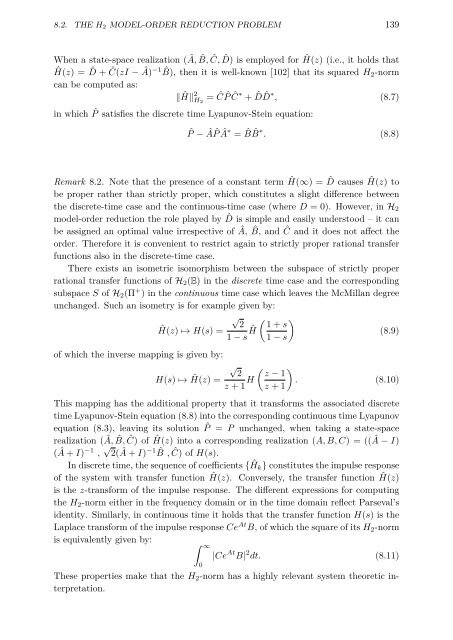link to my thesis
link to my thesis
link to my thesis
Create successful ePaper yourself
Turn your PDF publications into a flip-book with our unique Google optimized e-Paper software.
8.2. THE H 2 MODEL-ORDER REDUCTION PROBLEM 139<br />
When a state-space realization (Â, ˆB,Ĉ, ˆD) is employed for Ĥ(z) (i.e., it holds that<br />
Ĥ(z) = ˆD + Ĉ(zI − Â)−1 ˆB), then it is well-known [102] that its squared H2 -norm<br />
can be computed as:<br />
‖Ĥ‖2 H 2<br />
= Ĉ ˆP Ĉ∗ + ˆD ˆD ∗ , (8.7)<br />
in which ˆP satisfies the discrete time Lyapunov-Stein equation:<br />
ˆP − Â ˆP Â∗ = ˆB ˆB ∗ . (8.8)<br />
Remark 8.2. Note that the presence of a constant term Ĥ(∞) = ˆD causes Ĥ(z) <strong>to</strong><br />
be proper rather than strictly proper, which constitutes a slight difference between<br />
the discrete-time case and the continuous-time case (where D = 0). However, in H 2<br />
model-order reduction the role played by ˆD is simple and easily unders<strong>to</strong>od – it can<br />
be assigned an optimal value irrespective of Â, ˆB, and Ĉ and it does not affect the<br />
order. Therefore it is convenient <strong>to</strong> restrict again <strong>to</strong> strictly proper rational transfer<br />
functions also in the discrete-time case.<br />
There exists an isometric isomorphism between the subspace of strictly proper<br />
rational transfer functions of H 2 (E) in the discrete time case and the corresponding<br />
subspace S of H 2 (Π + ) in the continuous time case which leaves the McMillan degree<br />
unchanged. Such an isometry is for example given by:<br />
√ ( )<br />
2 1+s<br />
Ĥ(z) ↦→ H(s) =<br />
(8.9)<br />
1 − sĤ 1 − s<br />
of which the inverse mapping is given by:<br />
√ ( )<br />
2 z − 1<br />
H(s) ↦→ Ĥ(z) = z +1 H . (8.10)<br />
z +1<br />
This mapping has the additional property that it transforms the associated discrete<br />
time Lyapunov-Stein equation (8.8) in<strong>to</strong> the corresponding continuous time Lyapunov<br />
equation (8.3), leaving its solution ˆP = P unchanged, when taking a state-space<br />
realization (Â, ˆB,Ĉ) ofĤ(z) in<strong>to</strong> a corresponding realization (A, B, C) =((Â − I)<br />
(Â + I)−1 , √ 2(Â + I)−1 ˆB , Ĉ)ofH(s).<br />
In discrete time, the sequence of coefficients {Ĥk} constitutes the impulse response<br />
of the system with transfer function Ĥ(z). Conversely, the transfer function Ĥ(z)<br />
is the z-transform of the impulse response. The different expressions for computing<br />
the H 2 -norm either in the frequency domain or in the time domain reflect Parseval’s<br />
identity. Similarly, in continuous time it holds that the transfer function H(s) is the<br />
Laplace transform of the impulse response Ce At B, of which the square of its H 2 -norm<br />
is equivalently given by: ∫ ∞<br />
|Ce At B| 2 dt. (8.11)<br />
0<br />
These properties make that the H 2 -norm has a highly relevant system theoretic interpretation.

















